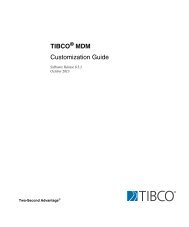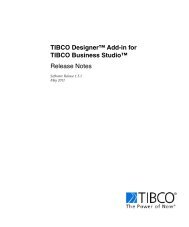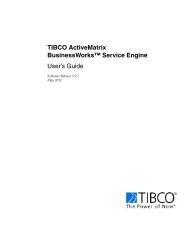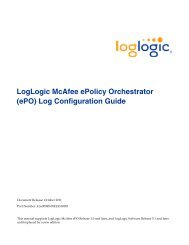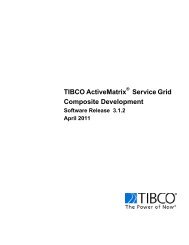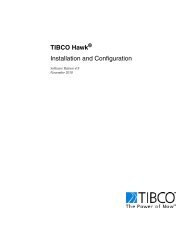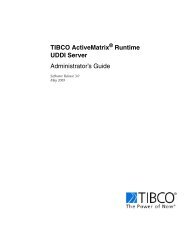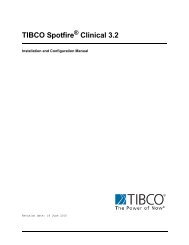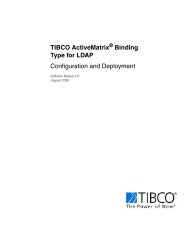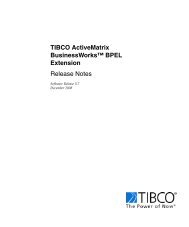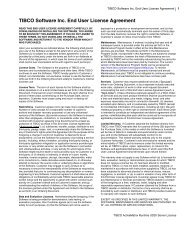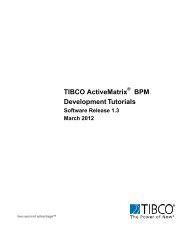TIBCO Spotfire Server 3.2.2 - TIBCO Product Documentation
TIBCO Spotfire Server 3.2.2 - TIBCO Product Documentation
TIBCO Spotfire Server 3.2.2 - TIBCO Product Documentation
You also want an ePaper? Increase the reach of your titles
YUMPU automatically turns print PDFs into web optimized ePapers that Google loves.
Authentication and User Directory<br />
Context<br />
Referral mode<br />
Username attribute<br />
Authentication attribute<br />
Custom LDAP Properties<br />
This option specifies which context or contexts of the<br />
LDAP directory you wish to read users from. A<br />
context can be an Organizational Unit, a Common<br />
Name, or any other container containing users. Use the<br />
Browse button to browse and select from the LDAP<br />
directory tree. You can also type the name of a context<br />
directly into the field.<br />
In a large LDAP Directory, different parts of the<br />
directory tree may be stored on different servers.<br />
When a search for users is made on one server, the<br />
result can therefore be a referral to a different server.<br />
This setting decides whether to conduct a follow-up<br />
search for the users in question on the referred server.<br />
The options are Follow, Ignore or Throw. The default<br />
and recommended value is Follow.<br />
In an LDAP Directory, a number of attributes are<br />
stored for each user. The actual username can be called<br />
different things on different brands of LDAP servers.<br />
If you select one of the LDAP directory server types<br />
listed under <strong>Server</strong> Type, this option will be preselected,<br />
but if you use a custom LDAP directory<br />
server, you will need to specify which user attribute is<br />
the username.<br />
This option specifies which user attribute should be<br />
used to authenticate the user. In almost all cases, this is<br />
the same as Username attribute and should not be<br />
specified.<br />
If you authenticate with a custom LDAP server, you<br />
may in some cases need to specify custom LDAP<br />
properties here. In most situations, however, you may<br />
leave this blank.<br />
If you lack any of this information, you need to speak to the person in charge of the<br />
LDAP system within your organization that can assist you before you can set up<br />
LDAP.<br />
8.2.2 <strong>Spotfire</strong> Database<br />
With this authentication method, all usernames and passwords are stored in the<br />
<strong>Spotfire</strong> database. This is the “stand-alone” solution, where no external authentication<br />
is used. No external configuration is required to set this up, but in return all users must<br />
be manually added using the Administration Manager tool found in the <strong>Spotfire</strong> client.<br />
This is recommended when no existing infrastructure can be used, or when the<br />
<strong>Spotfire</strong> system should be independent of any other systems.<br />
<strong>TIBCO</strong> <strong>Spotfire</strong>® <strong>Server</strong> <strong>3.2.2</strong> 67 (144)



